Remodernism
Remodernism revives aspects of modernism, particularly in its early form, and follows postmodernism, to which it contrasts. Adherents of remodernism advocate it as a forward and radical, not reactionary, impetus.[1][2]
In 2000, Billy Childish and Charles Thomson, founders of the stuckism art movement instigated remodernism,[3] with a manifesto, Remodernism in an attempt to introduce a period of new spirituality into art, culture and society to replace postmodernism, which they said was cynical and spiritually bankrupt. In 2002, a remodernism art show in Albuquerque was accompanied by an essay from University of California, Berkeley art professor, Kevin Radley, who said there was a renewal of artists working without the limitation of irony and cynicism, and that there was a renewal of the sense of beauty.
In 2006, the Stedelijk Museum and the University of Amsterdam held a talk on remodernism with Daniel Birnbaum and Alison Gingeras; the introduction to this talked of the revival of painting as a possible return to traditional modernist values, such as authenticity, self-expression and autonomy, as opposed to multimedia practice. [4] In 2008, London Evening Standard critic, Ben Lewis, applied the term to three Turner Prize nominees and saw them amongst a movement which was reviving the formalism of the early 20th century; he advocated values of an aesthetic informed by modesty, generosity and genuine emotion.[5]
History
Charles Thomson and Billy Childish, the founders of the stuckism art movement, inaugurated the period of remodernism.[3] Their Remodernism manifesto was published on March 1, 2000 to promote vision, authenticity and self-expression, with an emphasis on painting, and subtitled "towards a new spirituality in art." Its premise is that the potential of the modernist vision has not been fulfilled, that its development has been in the wrong direction and that this vision needs to be reclaimed, redefined and redeveloped. It advocates the search for truth, knowledge and meaning, and challenges formalism.
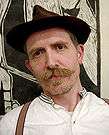 |
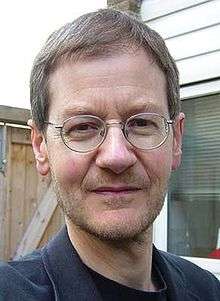 |
| In 1999, Childish and Thomson wrote a remodernism manifesto, calling for a period of new spirituality in art, culture and society to replace postmodernism. | |
It has a short introduction, summing up: "Modernism has progressively lost its way, until finally toppling into the bottomless pit of Postmodern balderdash." This is followed by 14 numbered points, stressing bravery, individuality, inclusiveness, communication, humanity and the perennial against nihilism, scientific materialism and the "brainless destruction of convention." Point 7 states:
Spirituality is the journey of the soul on earth. Its first principle is a declaration of intent to face the truth. Truth is what it is, regardless of what we want it to be. Being a spiritual artist means addressing unflinchingly our projections, good and bad, the attractive and the grotesque, our strengths as well as our delusions, in order to know ourselves and thereby our true relationship with others and our connection to the divine.
Point 9 states: "Spiritual art is not religion. Spirituality is humanity's quest to understand itself and finds its symbology through the clarity and integrity of its artists." Point 12 links its use of the word "God" to enthusiasm—from the Greek root en theos (to be possessed by God).
The summary at the end starts, "It is quite clear to anyone of an uncluttered mental disposition that what is now put forward, quite seriously, as art by the ruling elite, is proof that a seemingly rational development of a body of ideas has gone seriously awry," and finds the solution is a spiritual renaissance because "there is nowhere else for art to go. Stuckism's mandate is to initiate that spiritual renaissance now."[6]
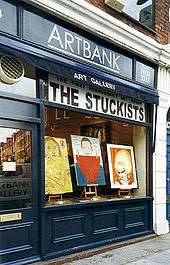
Childish and Thomson sent their remodernism manifesto to Sir Nicholas Serota, Director of the Tate Gallery, who replied, "You will not be surprised to learn that I have no comment to make on your letter, or your manifesto Remodernism."[8][9]
In March 2000 the Stuckists declared themselves to be the first remodernist art group at a show The Resignation of Sir Nicholas Serota. In April, remodernism was quoted in The Gulf News (UAE).[10] In May The Observer newspaper announced a stuckist show: "As the founding group of a self-named art movement called Remodernism, they stand on an art ticket that's against clever conceptualism and in favour of a more emotional and spiritual integrity in art via figurative painting."[11]
In June, Thomson and Childish gave a talk on stuckism and remodernism at the Salon des Arts, Kensington, promoted by the Institute of Ideas.[12] The same month the "Students for Stuckism" also gave "a Remodernist show and talk." The Institute of Remodernism was founded by Dr Khatereh Ahmadi.
In 2001, Thomson stood in the UK general election, stating, "The Stuckist Party aims to bring the ideas of Stuckism and Remodernism into the political arena."[13]
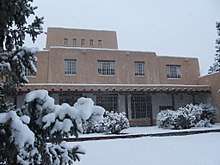
In January 2002, Magnifico Arts presented a show ReMo: ReModernism[14] of graduate students from the University of New Mexico. At an artists' talk, Kevin Radley, an art professor at the University of California, Berkeley said, "Remodernism isn't about going backwards, but about surging forward."[2] In an essay that accompanied the exhibition, Radley wrote:
...there seems to be a re-emergence of confidence in the artist's singular voice—a renewal of the belief that an artist can explore their own natures without the restraints of the ironic, the cynical or the didactic. To re-contact the notions of presence, reinvent their sense of beauty and renew our need for intimacy.[15]
The show curator, Yoshimi Hayashi, said:
ReMo incorporates ideas from Modernism, Avantegardism, and Post Modernism; thus synthesizing an alternative and real time contemporary approach to art. In ReMo, issues such as multiculturalism, irony, the sublime, and identity are considered; however, they do not become the art itself. The reconsideration and redefinition of the traditions are sought not by mere deconstructionism, but rather by connecting new nodes of ideas. Therefore, by definition, ReMo is fundamentally cellular and its roots stem from provincial art settings.[16]
In 2003, an independent group, the Stuckist Photographers, was founded by Andy Bullock and Larry Dunstan with a statement of endorsement for remodernism.[17]
In 2004, the Defastenists, a new group of creatives in Ireland, declared themselves remodernist.[18] A Remodernist art gallery, The Deatrick Gallery was founded in Louisville, Kentucky. American film makers/photographers Jesse Richards and Harris Smith co-founded a new group remodernist film and photography with an emphasis on emotional meaning and characterised by elements of new-wave, no-wave, expressionist and transcendental film-making.
Stuckist artist Bill Lewis, interviewed by the BBC at the 2004 Liverpool Biennial, said that remodernism was "not a movement as such,"[1] but a return to the start of modernism in order to move forward with an art for a new paradigm.[1] To "remodernise" is to go "back to the root again, starting with painting ... and see where it goes."[1] He said that this had been called reactionary, but it was radical "in the true sense of the word."[1] New York stuckist artist, Terry Marks said that remodernism posited that modernism had started in a good direction, but veered from that into "pure idea" and that it was necessary to return to the starting point to take an as-yet unexplored alternative direction: "to pursue art-making that's more concrete and accessible to more people, and find out where that leads us."[19]
In 2004, Luke Heighton wrote in The Future magazine, "Remodernism, it seems, is here to stay whether we like it or not."[20] Alex Kapranos of Franz Ferdinand declared 2004 "a good year for remodernism—for having the gall to suggest that artists can have souls." [21]
In August 2005 an art show Addressing the Shadow and Making Friends with Wild Dogs: Remodernism (a title taken from a line in the stuckist remodernism manifesto) was held at CBGBs 313 gallery in New York City.[22] Artist and blogger Mark Vallen said, "In the mid-1970s punk rock was born in a dank little New York nightclub called CBGB's. It all started when rockers like Television, the Ramones and Patti Smith launched a frontal assault on the monolith of corporate rock 'n roll. Now another artistic revolt, Remodernism, is about to widen its offensive from the birthplace of punk."[22]
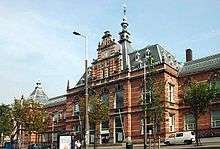
On May 10, 2006, the Stedelijk Museum and the University of Amsterdam staged a talk on remodernism by Daniel Birnbaum, contributing editor of Artforum, and Alison Gingeras, Assistant Curator, Guggenheim Museum.[4] The summary is:
Recently, we have been witness to yet another resurgence of interest in painting. Should we view the revitalization of this ancient medium as a return to traditional modernist values like autonomy, authenticity and self-expression? If indeed we can speak of a return to modernism (remodernism), where will this leave multimedial and transdisciplinary practice in the arts?[4]
In August 2006, an online group called "The Remodernists of Deviantart" was founded by Clay Martin. The group is composed of artists who are active on the website deviantart.com.
In 2006, artist Matt Bray said, "I do not wish to be considered a Stuckist, as I find some of there (sic) antics unnecessary. The Stuckists are however the first and most famous Remodernist group, so for that, and for bringing this particular manifesto to my attention; I thank them."[23] In May 2007, with punk singer Adam Bray, he created the Mad Monk Collective in Folkestone, England, to promote remodernism.[24]
In January 2008, London Evening Standard critic, Ben Lewis, said the year would see "the invention of a new word to describe the modernist revival: 'remodernism,'"[25] which he applied later in the year to Turner Prize nominees Mark Leckey, Runa Islam and Goshka Macuga, as "part of a whole movement reviving early 20th-century formalism," praising Macuga for her "heartfelt, modest and generous-spirited aesthetic," of which he said there was more needed today.[5] In April 2009, he described Catalina Niculescu, a Romanian artist using "nostalgic"[26] 16mm film, as among a significant trend in art of fetishising the offcuts of modernism: "Let's call it Remodernism."[26]
On August 27, 2008, Jesse Richards published a Remodernist Film Manifesto, calling for a "new spirituality in cinema," use of intuition in filmmaking, as well as describing the remodernist film as being a "stripped down, minimal, lyrical, punk kind of filmmaking". The manifesto criticizes Stanley Kubrick, filmmakers who use digital video, and Dogme 95. Point 4 says:
The Japanese ideas of wabi-sabi (the beauty of imperfection) and mono no aware (the awareness of the transience of things and the bittersweet feelings that accompany their passing), have the ability to show the truth of existence, and should always be considered when making the remodernist film.[27]
Later, in 2009, in an essay on remodernist film for MungBeing magazine, Richards discussed Remodernism in relation to craft:
Remodernism in general embraces the bravery of the amateur, so craft is a strange thing to think about. Craft is usually about something striving for perfection, without flaws, to be "professional". I don't like that. However if you consider craft something that can be developed and grown, I like that. I like the idea of filmmakers teaching themselves to paint pictures, to try acting in their own movies and those of others (especially if they are shy), to be nude models for other artists, to meditate, worship if they are religious, to do things that affect their levels of consciousness, try things that make them nervous or uncomfortable, to go out and be involved in life, to find adventure, to jump in the ocean. I think that is the exploration of craft.[28]
In 2009, Nick Christos and other students from Florida Atlantic University founded the Miami Stuckists group. Christos said, "Stuckism is a renaissance of modernism—it's re-modernism."[29]
See also
References
- Lewis, Bill. "Listen to Bill Lewis on Remodernism" (audio) in: Sumpter, Helen. "Liverpool Biennial 04", BBC, 4 September 2004. Retrieved 22 September 2009.
- Medina, Valerie J. (2002)"Modern art surges ahead:¡Magnifico! features new artistic expression" Daily Lobo, January 17, 2002. Accessed April 29, 2006
- Packer, William. "Childish artists coming unstuck", p.13, and "Young pretenders of art have much to learn", p. 20, Financial Times, March 13, 2001. The text from different editions is the same: "Childish and his co-founder, Charles Thomson, ushered in remodernism, 'a period of art . . . to reclaim the vision and spiritual values of the early Modernists and replace the ennui of Post-Modernism'."
- "Right about now: Remodernism" University of Amsterdam. Accessed April 29, 2006
- Lewis, Ben. "Turner Prize 2008", 3 October 2008. Retrieved 22 September 2009.
- Childish, Billy, and Thomson, Charles. "Remodernism", stuckism.com, March 1, 2000. Accessed September 12, 2007.
- Listed as "Best London exhibition of the week" in The Guardian Guide. Source: Stuckism.com.
- "Stuck on the Turner Prize: Send in the clowns", University of Glasgow. Retrieved from Internet Archive cache of December 21, 2002.
- Kennedy, Maeve "Shock of the old as paint returns to the Turner Prize", The Guardian, October 24, 2000. Accessed September 12, 2007.
- Lethbridge, Lucy (2000)"Letter from London" The Gulf News, May 14, 2000. Accessed April 29, 2006
- Sumpter, Helen (2000)"Go see... the Stuckists" The Observer, May 14, 2000. Accessed April 29, 2006
- "Stella Vine meets (and joins) the Stuckists" stuckism.com. Accessed April 29, 2006
- "The Stuckist Party: Manifesto 2001" pdf accessed from Keele University website, April 29, 2006.
- "Magnifico presents ReMo: ReModernism", Magnifico 2002. Retrieved from the Internet Archive store of 21 January 2002.
- Radley, Kevin (2002)"RE MODernism: Trajectories towards the NU Modern" magnifico.org, January 1, 2002. Retrieved from the Internet Archive.
- "Magnífico presents ReMo", Magnifico, 2002. Retrieved from the Internet Archive store of 7 February 2002.
- "The Stuckists Photographers", Walker Art Gallery, National Museums Liverpool. Accessed September 12, 2007.
- "News: Defastenism—A Remodernist art group", stuckism.com, 13 May 2004. Retrieved 15 October 2009.
- Strickland, Carol. "Stuckist in New York City: An Interview with Narrative Painter Terry Marks", NYArts, September/October 2004. Accessed October 15, 2009.
- Heighton, Luke (2004)"Dead Painters Society"The Future. Accessed April 29, 2006
- Kapranos, Alex. "Alex Kapranos, singer/guitarist, Franz Ferdinand" in: "The triumphs and turkeys of 2004", The Guardian, December 16, 2004. Accessed April 29, 2006
- Vallen, Mark. "Stuckists at CBGBs", Art-for-a-change, 2 August 2005. Retrieved June 1, 2008.
- Bray, Matt (2006)"Art Portal: Matt Bray 2006" artnow.uk.com. Accessed April 29, 2006
- Mad Monk (2007)"Mad Monk", Mad Monk Books. Accessed May 2008
- Lewis, Ben. "The London galleries to watch, Evening Standard, 18 January 2008. Retrieved 22 September 2009.
- Lewis, Ben. "Exhibition: Atalina Nicolescu/Maurizio Anzeri", Evening Standard, p.36, 28 April 2009.
- "Remodernist Film Manifesto", When The Trees Were Still Real, August 27, 2008 Retrieved September 1, 2008
- "Remodernist Film", MungBeing, October 4, 2009 Retrieved October 5, 2009
- Soler, Eilenn. "Stuckists display art", The Miami Herald, August 29, 2009. Retrieved September 21, 2009.
Further reading
- Ed. Katherine Evans (2000), The Stuckists: The First Remodernist Art Group, Victoria Press, ISBN 0-907165-27-3
- Ed. Frank Milner (2004), The Stuckists Punk Victorian, National Museums Liverpool, ISBN 1-902700-27-9
External links
- Remodernism Manifesto (in English, French, German, Persian, Portuguese and Spanish)
- Charles Thomson on the writing of the Remodernism manifesto
- Remodernism manifesto in the Tate Gallery